The recent resurgence in NCE approval numbers continued in 2013, after several years in the doldrums. And, once again, treatments for various forms of cancer dominated the list of new drugs given a positive opinion by the European Medicines Agency’s committee for medicinal products for human use, or CHMP. And the list of new cancer drugs was itself dominated by new receptor tyrosine kinase inhibitors.
Many of these are implicated in cancer pathways, and their innate drugability has led to much attention from pharma researchers. New tyrosine kinase inhibitors in 2013 include Boehringer Ingelheim’s afatinib (Giotrif). Approved for the treatment of patients with locally advanced or metastatic non-small cell lung cancer who have not previously been given tyrosine kinase inhibitors against EGFR, it covalently binds to dimers of several ErbB tyrosine kinases, including EGFR, HER2, ErbB3 and ErbB4, blocking their signalling processes.
Bayer’s regorafenib (Stivarga) was also given the go-ahead. Again, it is a multi-kinase inhibitor. The targets it blocks include three VEGF subtypes plus TIE2 that are involved in tumour angiogenesis; KIT, RET, RAF-1, BRAF and BRAF-v600E, implicated in oncogenesis; and both PDGFR and FGFR, which are involved in the tumour micro-environment. Its initial licence is for patients with pre-treated, metastatic colorectal cancer.
Another multi-kinase inhibitor, cabozantinib (Cometriq) from TMC Pharma Services/Exelixis, has activity against various kinases involved in tumour growth and angiogenesis, bone remodelling and the formation of metastases, notably c-MET and VEGFR2. It has been approved for the treatment of medullary thyroid cancer that is progressive and unresectable, and either locally advanced or metastatic.
More targeted is dabrafenib (Tafinlar) from GlaxoSmithKline. This is designed to treat patients with unresectable or metastatic melanoma that expresses the BRAF serine threonine kinase with a mutation at position 600. Nearly half of all melanomas have this mutation, and it gives the tumour the ability to make an abnormal protein that promotes the cancer growth. Dabrafenib slows this process down.
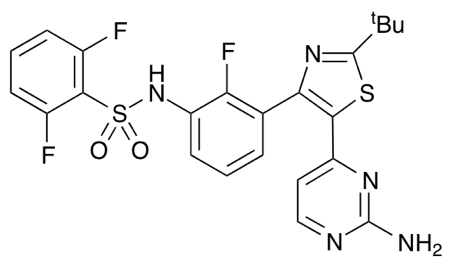
Dabrafenib

Enzalutamide
Several other anticancer drugs acting by different mechanisms were also approved. For example, Astellas’s enzalutamide (Xtandi) is an androgen receptor signalling inhibitor designed to block several steps within this signalling pathway. It is licensed to treat men with metastatic and castration-resistant prostate cancer that has progressed despite prior docetaxel therapy.
A new treatment for multiple myeloma, pomolidomide from Celgene, is designed to be administered in combination with the anti-inflammatory dexamethasone. The thalidomide derivative not only has a direct tumoricidal activity, it also has immunomodulatory properties and inhibits stromal cell support for the growth of multiple myeloma tumour cells. Unsurprisingly, bearing in mind its structural similarity to thalidomide, teratogenic effects are anticipated.
While all of these cancer therapies are small molecules, one new biologic was approved. Roche’s trastuzumab emtansine (Kadcyla) is an antibody directed conjugate, where the monoclonal antibody trastuzumab – already familiar as the breast cancer treatment Herceptin – is connected via linker molecules to the highly potent cytotoxic drug emtansine. The antibody is designed to bind to the HER2 extracellular domain in HER2+ breast cancer tumours, and after endocytosis the cytotoxic drug is released within the cell, where it binds to tubulin and induces apoptosis. It should also reduce side-effects by ensuring that the damaging cytotoxic agent does not indiscriminately attack healthy cells on its way through the body.

Dolutegravir
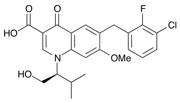
Elvitegravir
Away from cancer, a number of different anti-infective medicines were given the go-ahead. These include two new HIV-1 integrase strand transfer inhibitor drugs: elvitegravir (Vitekta) from Gilead and dolutegravir (Tivicay) from Viiv. These drugs prevent DNA from the virus from integrating into host genomic DNA. This results in the prevention of the formation of HIV-1 provirus, and stops the viral infection from propagating. They are licensed for use in combination with other antiretroviral medicines, including a ritonavir-boosted protease inhibitor.
Another new medicine from Gilead for use in HIV combination therapy, cobicistat (Tybost), is designed to act as a pharmacokinetic enhancer of the protease inhibitors atazanavir and darunavir. These two drugs are both metabolised via cytochromes P450 of the CYP3A subtype. Cobicistat was designed to inhibit this metabolic process, and thus enhance the systemic exposure of drugs that are metabolised in this way.
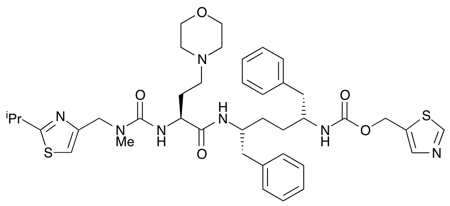
Cobicistat
Hepatitis C remains an unmet therapeutic need because of the requirement for long-term and unpleasant drug treatment that all too often fails to clear the virus. Sofosbuvir (Sovaldi) from Gilead/Pharmasset is the first treatment that does not have to be administered in combination with an interferon. It inhibits the NS5B ribonucleic acid polymerase enzyme that the hepatitis C virus requires to replicate. The new drug is given alongside ribavirin, and can also be added to a standard interferon-based regime, in which case it cuts the treatment time down to just 12 weeks, from the normal 24 to 48 weeks.
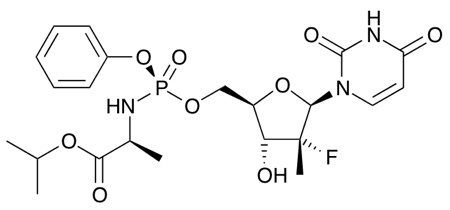
Sofosbuvir
On the antibacterial side, two new medicines for another unmet medical need – multidrug-resistant tuberculosis – were approved. Otsuka’s delamanid (Deltyba) acts by inhibiting the synthesis of two mycobacterial cell wall components, methoxymycolic and ketomycolic acids, and is designed to be used alongside other antibacterial drugs. The second, para-aminosalicylic acid (Lucane), meanwhile, competes with paraminobenzoic acid for the enzyme dihydropteroate synthetase, which is involved in the biosynthesis of folates. It is actually a new formulation of an old drug, which fell out of favour in the 1970s, but it has started to be used once more to combat the emergence of multidrug resistant strains.

Delamanid
Three new treatments for multiple sclerosis were also recommended for authorisation – two small molecules and one biologic. The antibody product alemtuzumab (Lemtrada) from Genzyme is a humanised monoclonal antibody directed against the cell surface glycoprotein CD52, and although the way it works in MS is unclear, it may be by immunomodulatory means, via the depletion and repopulation of lymphocytes.

Teriflunomide
Also from the Sanofi group is teriflunomide (Aubagio), a selective immunosuppressant that has anti-inflammatory properties. Again, the exact mechanism is unclear but it is thought to involve reducing the proliferation of lymphocytes by blocking the mitochondrial enzyme dihydroorotate dehydrogenase.
Biogen Idec’s dimethyl fumarate (Tecfidera) is also indicated for the treatment of relapsing-remitting multiple sclerosis. The nervous system drug appears to act via triggering the activation of the nuclear factor (erythroid-derived 2)-like 2, or Nrf2, transcriptional pathway. It appears to reduce the number of relapses.
The latest addition to the anti-depressant arsenal, vortioxetine (Brintellix) from Lundbeck, acts as a direct modulator of serotonergic receptor activity and an inhibitor of the serotonin transporter. It has been approved for the treatment of major depressive episodes in adults.
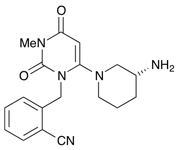
Alogliptin
With Type II diabetes still representing a significant – and growing – public health problem, it is unsurprising that new treatments continue to be developed. Newly approved last year is alogliptin (Vipidia) from Takeda. This is a dipeptidyl peptidase 4, or DPP-4, inhibitor. Blocking this enzyme results in a reduction in the cleavage and inactivation of the active forms of the incretin hormones glucagon-like peptide one and glucose-dependent insulinotropic polypeptide. The result is the enhancement of glucose-dependent insulin secretion, alongside a reduction in the release of glucagon. It is designed to be used in combination with other glucose lowering drugs.
Also new for diabetes is Janssen-Cilag’s canagliflozin (Invokana). It blocks sodium-glucose co-transporter 2, or SGLT-2, in the kidneys. The result is a reduction of the reabsorption of glucose in the kidney, increasing its excretion in the urine and reducing the amount that remains in the bloodstream. It is licensed both for monotherapy in patients who cannot tolerate metformin, and in combination with insulin and other insulin-lowering drugs where these do not give sufficient glycaemic control.
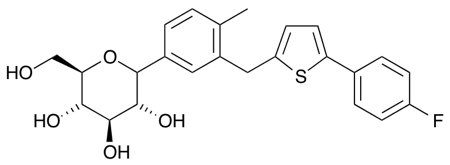
Canagliflozin
Patients with homozygous familial hypercholesterolaemia have extremely high levels of low-density lipoprotein that cannot be controlled using standard cholesterol-lowering drugs such as statins. Lomitapide (Lojuxta) from Aegerion Pharmaceuticals is a selective inhibitor of microsomal transfer protein.

Lomitapide
This intracellular lipid transfer protein is responsible for the binding and shuttling of lipids between membranes, and is involved in the assembly of apo-B-containing lipoproteins in the intestines and liver. By inhibiting this protein, lipoprotein secretion is reduced, and the circulating concentrations of lipids such as cholesterol and triglycerides that are carried by lipoproteins also fall. It is able to reduce LDL levels by about 40% in patients with this disorder.
Pulmonary arterial hypertension remains difficult to treat, and a new therapy option has been approved in the form of Actelion’s macitentan (Opsumit). This drug acts as a dual endothelin-A and endothelin-B receptor antagonist. It binds to these receptors in human pulmonary arterial smooth muscle cells, stopping endothelin-mediated activation of the secondary messenger systems that lead to vasoconstriction and smooth muscle cell proliferation.
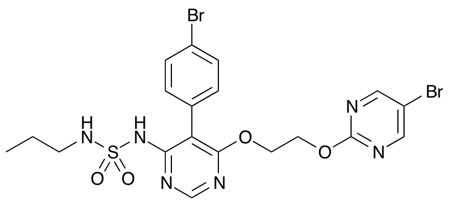
Macitentan
New entry in ED market
One might think that the erectile dysfunction market was saturated, especially in the light of the expiry of Pfizer’s patent on sildenafil (Viagra). However, a fourth product in this class was approved last year, with a faster onset of action: avanafil (Spedra) from Vivus.
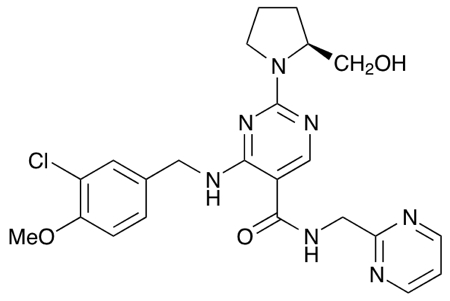
Avanafil
The selective phosphodiesterase-5 inhibitor causes an increase in cyclic guanosine monophosphate-specific PDE5 levels, enhancing smooth muscle relaxation and resulting in a greater flow of blood into the tissues in the penis.

Brimonidine
Galderma’s brimonidine tartrate (Mirvaso) is a new treatment for facial erythema of rosacea. The drug is an alpha-2 adrenergic agonist that has potent vasoconstrictive and vasostabilising activity. As rosacea results from the permanent vasodilatation of small blood vessels, vasoconstriction, mediated by its influence on these receptors in post-synaptic smooth muscle, can help reduce facial erythema in patients with the condition.
A new alternative for the treatment of haemophilia was also approved. Novo Nordisk’s turoctocog alfa (NovoEight) is a human recombinant factor VIII that facilitates the temporary substitution of the endogenous coagulation factor VIII in patients with type A haemophilia. It is designed to treat bleeding in patients with this type of haemophilia, which is characterised by a congenital deficiency of factor VIII, and also as prophylaxis.
Nephropathic cystinosis is an orphan lysosomal storage disease in which the amino acid cystine accumulates in various cells. Mercaptamine (Procysbi) from Raptor Pharmaceuticals can reduce the accumulation of cystine in cells such as liver, muscle and leukocytes, and if treatment starts sufficiently early it can delay the onset of kidney failure. Its activity arises from its ability to participate in a thiol disulfide interchange reaction within the lysosomes that converts cystine into cysteine and cysteine-cysteamine mixed disulfide. Both of these are able to exit the lysosome in patients suffering from this condition, unlike cystine.
Ocriplasmin (Jetrea) is a novel treatment from ThromboGenics designed to treat vitreomacular traction. On ageing, the vitreous humour in the eye shrinks, and this can cause a pulling on the macula, resulting in visual disturbances and, in the worst cases, holes in the macula. Ocriplasmin provides an alternative to surgical treatment. The recombinant enzyme acts against proteins within the interface between the vitreous humour and the retina; breaking these loosens the adhesion between the macula and the vitreous humour, thus reducing the tension. A single dose should suffice; this is a far less invasive procedure than surgery to remove the vitreous humour, a procedure that requires a significant recovery process, including at least a week spent in a head-down position.
A particularly notable approval was Genzyme’s Maci, or matrix applied characterised autologous cultured chondrocytes. This is the first combined tissue-engineered medicine to gain authorisation across the EU. The advanced therapy medicinal product is an implant designed for the repair of full thickness cartilage defects of the knee up to 20cm2 in size. Cartilage damage is a common sporting injury, and problems with the smooth cartilage surface of the knee joint leads to an increase in rubbing, which in turn can lead to further erosion to the cartilage. The ultimate result is osteoarthritis.
Autologous chondrocyte implantation was first described 20 years ago; patient-derived cartilage cells were grown outside the body and then transplanted back. Maci is new because it uses a porcine collagen scaffold on which the autologous chondrocytes are seeded. This scaffold is trimmed to the size and shape of the cartilage defect before trans-plantation, and held in place with fibrin glue.
Advanced therapies
Another new advanced therapy product is Dendreon’s Provenge, a cellular immunotherapy product designed to induce an immune response against prostate cancer cells. Immune cells are extracted from the patient, grown outside the body, and then infused back. They then trigger an immune response against an antigen present in metastasised prostate cancer cells. It is authorised for the treatment of asymptomatic or minimally symptomatic metastatic castrate-resistant prostate cancer in patients for whom chemotherapy is not yet clinically indicated.
Finally, while not new drugs, the approval of Celltrion Healthcare’s Remsima and Inflextra from Hospira are noteworthy, as they represent the first biosimilars of monoclonal antibody drugs to reach the market. Both are versions of Janssen’s infliximab (Remicade), which has been available in Europe for 15 years now, to treat a range of autoimmune disorders such as Crohn’s disease and ulcerative colitis, ankylosing spondylitis, psoriasis, and both rheumatoid and psoriatic arthritis. Europe continues to lead the way in this area – a dozen different biosimilars have been made available in the EU since the first was approved back in 2006. In contrast, the US is still arguing over the regulatory pathway, and biosimilars remain a dream.




